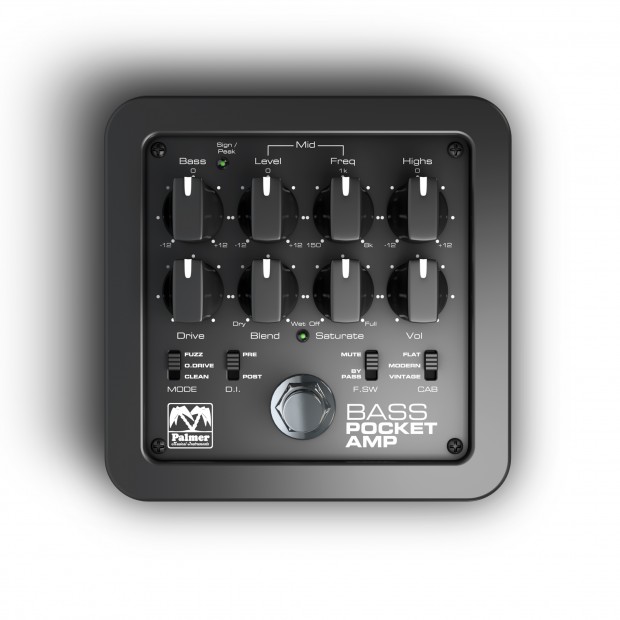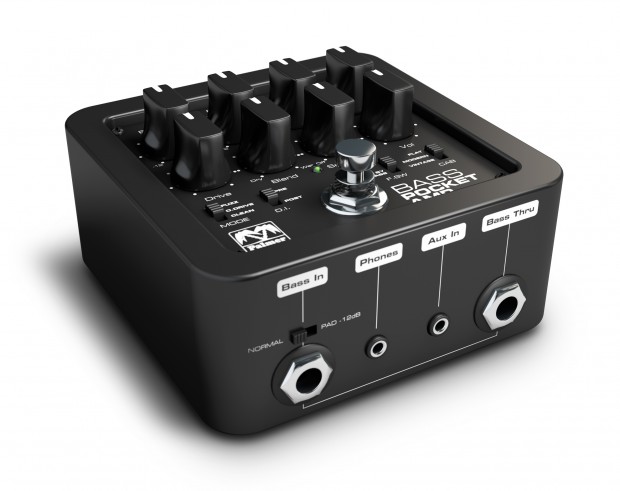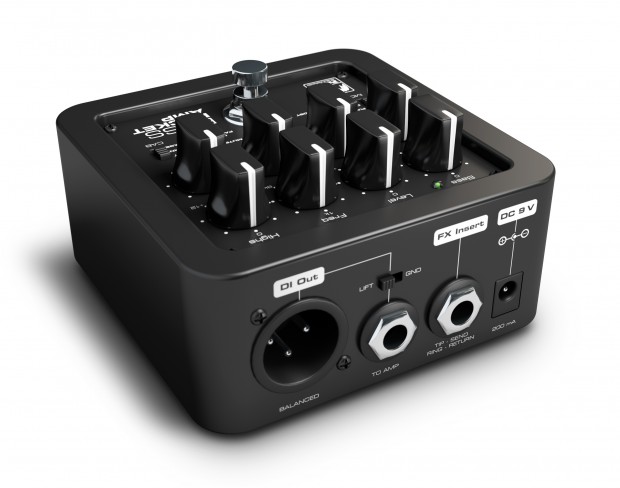Palmer Pocket Amp Bass – Report by Guitarrista
We recently had the opportunity to test the Palmer Pocket Amp MK2 preamp. Its excellent results lived up to all of our expectations for a product from this brand. Today, we’re testing a very similar product but that’s been designed for basses and, at a brief glance, looks to offer even more options.

Design
The box that houses the Pocket Amp Bass is similar to that of the Pocket Amp MK2 but in this case is completely painted black and has a higher number of knobs, slider switches and connectors. The upper panel has two rows of knobs and one of switches. The top row of knobs features an EQ with semi-parametric mids: Bass (+/-12 dB, centre at 90 Hz), Mid Level (+/-12 dB), Mid Freq (from 150 Hz to 8 kHz) and Highs (+/-12 dB, centre at 7 kHz). Between the Bass and Mid Level is a green LED labelled Sign/Peak. The bottom row of knobs features Drive, which controls the level of gain depending on the Mode switch setting (Clean/O.Drive/Fuzz); Blend controls the mix of direct and processed signals; Saturate adjusts the level of a ‘tape saturation simulation’ to obtain a warm, heavy sound and is before the FX output in the circuit; Vol controls the general volume. We’ve already talked about the Mode switch; the D.I. (Pre/Post) switch affects the XLR output; the F.SW. switch (Mute/Bypass) changes the configuration of the footswitch to silence it (to tune or change an instrument) or cut the signal; Cab (Vintage/Modem/Flat) selects the frequency response of the speaker emulation. A red status LED sits above the footswitch.

The front panel has a jack input for an instrument with a switch (Normal/Pad -12 dB) for attenuating the signal of the active basses; a mini jack for headphones; an auxiliary input mini jack and a Bass Thru jack. The rear panel provides a DI SLR balanced output and a jack output for an amp together with a ground loop switch (Lift/Gnd) associated with both; a female stereo jack for external effects that requires a Y-cable (Tip – Send, Ring – Return) and the power socket for a barrel connector (DC 9 V, 200 maA, negative in the centre). The base is covered with non-slip rubber except for the easy-access battery compartment and the four corner screws.
Sound
Thanks to the Mode and Cab switches there are six general sound shaping options before even starting to play with the EQ, which is far more complete and flexible than on the guitar preamp. This makes it extremely easy to achieve not only clean sounds with a punch, from aggressive trebles that assist the slap or tapping to full and rounded dub bass, but also different saturation levels, which can be mixed with the signal without becoming saturated thanks to the Blend knob and therefore don’t lose the clear definition that bass requires in almost all situations. The Saturate control can be used to limit the external effects that you put in the loop but also, and more importantly, to add width to the signal – an extremely practical feature when using a fretless bass.

Conclusion
In summary, it’s true that the saturation has limited use for bass in most situations but everything else the Pocket Amp Bass offers is extremely useful for any bassist, whether on stage, in the studio or at home. Right now, you might not think you need this product but if you try it, we can almost guarantee that you’ll want it.
Pros: Extremely versatile and compact, good sounds, simple and precise controls
Cons: –
Spezifications Palmer Pocket Amp Bass
Price: 189 €
Product type: Guitar Amplifiers
Technology: solid state
Inputs: 2
Input connectors: 6.3 mm Jack
Input impedance: 1 M Ohm(s)
Outputs: 4
Output connectors: 2 x 6.3 mm TS, 3.5 mm jack, XLR
Output impedance: TRS 10000, XLR 510 Ohm(s)
Channels: 1
Indicators: on/off, peak, signal
Controls: Bass, Drive, ground lift, highs, input pad, Mid, mid frequency, mode, mute, Pre/Post, volume
FX loop: yes
Operating voltage: 9 – 12 V DC, 9 V block
Cabinet material: die-cast aluminium
Dimensions: 100 x 100 x 55 mm
Weight: 0.36 kg
More informationen:
www.palmer-germany.com
Source: Magazine “Guitarrista”, Spain, February 2017











